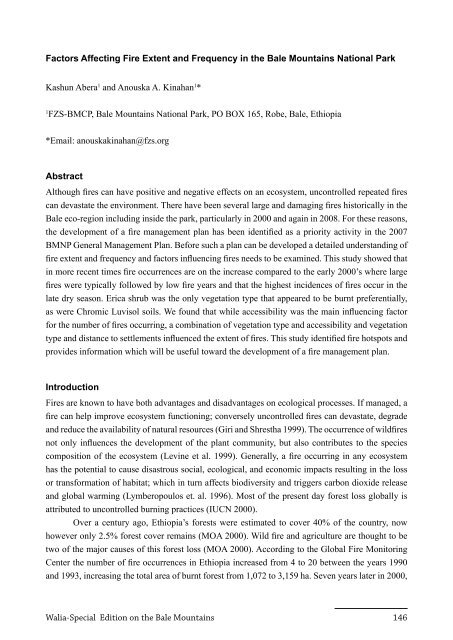Walia Special Edition on the Bale Mountains (2011) - Zoologische ...
Walia Special Edition on the Bale Mountains (2011) - Zoologische ...
Walia Special Edition on the Bale Mountains (2011) - Zoologische ...
You also want an ePaper? Increase the reach of your titles
YUMPU automatically turns print PDFs into web optimized ePapers that Google loves.
Factors Affecting Fire Extent and Frequency in <strong>the</strong> <strong>Bale</strong> <strong>Mountains</strong> Nati<strong>on</strong>al Park<br />
Kashun Abera 1 and Anouska A. Kinahan 1 *<br />
1 FZS-BMCP, <strong>Bale</strong> <strong>Mountains</strong> Nati<strong>on</strong>al Park, PO BOx 165, Robe, <strong>Bale</strong>, Ethiopia<br />
*Email: anouskakinahan@fzs.org<br />
Abstract<br />
Although fires can have positive and negative effects <strong>on</strong> an ecosystem, unc<strong>on</strong>trolled repeated fires<br />
can devastate <strong>the</strong> envir<strong>on</strong>ment. There have been several large and damaging fires historically in <strong>the</strong><br />
<strong>Bale</strong> eco-regi<strong>on</strong> including inside <strong>the</strong> park, particularly in 2000 and again in 2008. For <strong>the</strong>se reas<strong>on</strong>s,<br />
<strong>the</strong> development of a fire management plan has been identified as a priority activity in <strong>the</strong> 2007<br />
BMNP General Management Plan. Before such a plan can be developed a detailed understanding of<br />
fire extent and frequency and factors influencing fires needs to be examined. This study showed that<br />
in more recent times fire occurrences are <strong>on</strong> <strong>the</strong> increase compared to <strong>the</strong> early 2000’s where large<br />
fires were typically followed by low fire years and that <strong>the</strong> highest incidences of fires occur in <strong>the</strong><br />
late dry seas<strong>on</strong>. Erica shrub was <strong>the</strong> <strong>on</strong>ly vegetati<strong>on</strong> type that appeared to be burnt preferentially,<br />
as were Chromic Luvisol soils. We found that while accessibility was <strong>the</strong> main influencing factor<br />
for <strong>the</strong> number of fires occurring, a combinati<strong>on</strong> of vegetati<strong>on</strong> type and accessibility and vegetati<strong>on</strong><br />
type and distance to settlements influenced <strong>the</strong> extent of fires. This study identified fire hotspots and<br />
provides informati<strong>on</strong> which will be useful toward <strong>the</strong> development of a fire management plan.<br />
Introducti<strong>on</strong><br />
Fires are known to have both advantages and disadvantages <strong>on</strong> ecological processes. If managed, a<br />
fire can help improve ecosystem functi<strong>on</strong>ing; c<strong>on</strong>versely unc<strong>on</strong>trolled fires can devastate, degrade<br />
and reduce <strong>the</strong> availability of natural resources (Giri and Shrestha 1999). The occurrence of wildfires<br />
not <strong>on</strong>ly influences <strong>the</strong> development of <strong>the</strong> plant community, but also c<strong>on</strong>tributes to <strong>the</strong> species<br />
compositi<strong>on</strong> of <strong>the</strong> ecosystem (Levine et al. 1999). Generally, a fire occurring in any ecosystem<br />
has <strong>the</strong> potential to cause disastrous social, ecological, and ec<strong>on</strong>omic impacts resulting in <strong>the</strong> loss<br />
or transformati<strong>on</strong> of habitat; which in turn affects biodiversity and triggers carb<strong>on</strong> dioxide release<br />
and global warming (Lymberopoulos et. al. 1996). Most of <strong>the</strong> present day forest loss globally is<br />
attributed to unc<strong>on</strong>trolled burning practices (IUCN 2000).<br />
Over a century ago, Ethiopia’s forests were estimated to cover 40% of <strong>the</strong> country, now<br />
however <strong>on</strong>ly 2.5% forest cover remains (MOA 2000). Wild fire and agriculture are thought to be<br />
two of <strong>the</strong> major causes of this forest loss (MOA 2000). According to <strong>the</strong> Global Fire M<strong>on</strong>itoring<br />
Center <strong>the</strong> number of fire occurrences in Ethiopia increased from 4 to 20 between <strong>the</strong> years 1990<br />
and 1993, increasing <strong>the</strong> total area of burnt forest from 1,072 to 3,159 ha. Seven years later in 2000,<br />
<str<strong>on</strong>g>Walia</str<strong>on</strong>g>-<str<strong>on</strong>g>Special</str<strong>on</strong>g> <str<strong>on</strong>g>Editi<strong>on</strong></str<strong>on</strong>g> <strong>on</strong> <strong>the</strong> <strong>Bale</strong> <strong>Mountains</strong> 146
















